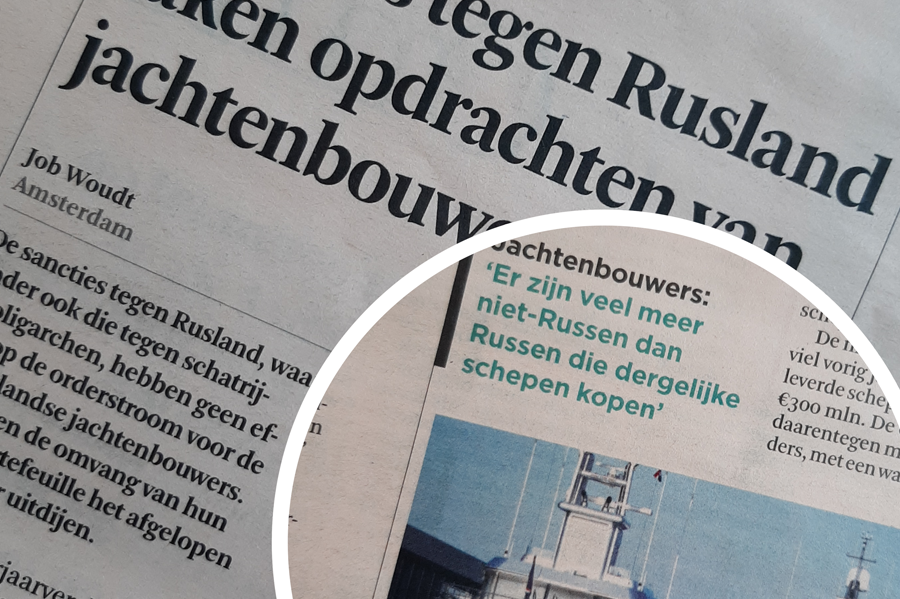The Russian invasion of Ukraine has affected the Dutch shipbuilding industry in skewed ways, shows the annual sector report recently published by the Netherlands Maritime Technology (NMT). The Dutch superyacht industry has been largely unaffected, while the inland shipping sector, fishing, and commercial vessels are following a gloomier trend.
Heesen Yachts, one of the largest shipbuilding companies in The Netherlands and formerly owned by Russian oligarch Vagit Alikperov, experienced the consequences of Russian sanctions only briefly. A Dutch foundation was able to take over ownership a couple of months into the Russian invasion, safeguarding the existence of the company.
Dutch made superyachts, the hot buns in the market
The lack of effect of Russian sanctions on the Dutch shipbuilding company mirrors the larger Superyacht shipbuilding industry in The Netherlands. The NMT sector report presented on Monday highlights how Dutch superyacht builders have been able to maintain their prominent position in the world market.
As reported by ‘het Financieele Dagblad’ in June 2023, last year the yards received 25 orders, bringing the total orders to 69 yachts with a total value of €6.6 billion. Only a year before the value of the portfolio was still € 5.9 billion, with 64 yachts remaining to be built.
Russian oligarchs blacklisted
After the Russian invasion of Ukraine in February 2021, the European Union responded with multiple massive sanctions. Included in those sanctions are different Russian oligarchs who are blacklisted due to their ties with Vladimir Putin. The Netherlands has an important role in building ‘superyachts’ and the industry worried sanctions would affect the purchase of these luxury vessels negatively. However, an NMT spokesman explains how these numbers eliminate this concern. “There are way more non-Russians than Russians who buy these ships”.
Nevertheless, Dutch shipbuilders still were unable to deliver some ships due to blacklisted companies. The 100 million euros loss in revenue, however, is only a drop in the ocean compared to the total revenue of 1.2 billion euros in the entire industry.
The inland shipping sector, commercial vessels, and fishing
In contrast to the luxury shipyard industry, there is a downward trend on ships bought for the inland shipping sector, fishing, and commercial vessels as reported by ‘het Financieel Dagblad’. Where in 2021 seventy vessels were bought for inland shipping, in the past year this decreased to merely forty.
The war in Ukraine did affect fishing negatively. The gas oil price rose to a record high, making it unprofitable for many fishing boats to set sail for months. Generally, 2022 was a bad year for the Dutch fishing industry. Planned wind farms and stricter nature legislation make it more difficult to fish.
At the end of 2022, the Dutch government opened a remediation scheme, for which just under eighty ships have been registered. The number of registrations for the government plan, which was implemented in response to Brexit, shows a decrease in the number of ships. This downward trend is reflected in the numbers of the NMT report. According to the report as quoted in ‘het Financieele Dagblad’ only three new fishing vessels have been produced.
Overall, the new construction of seagoing vessels was disappointing last year, with 31 ships delivered and a value of €300 million. Order intake, on the other hand, increased by almost 50%: 49 orders with a value of €600 million. The Dutch superyacht building industry is enduring. Nevertheless, the NMT report highlights clear differences within the shipyard industry, where not every sector encounters similar successes.
This text is based on an article originally published in Dutch by Job Woudt for ‘Het Financeele Dagblad’, June 2023. “Orderboek superjachtenbouwers goed gevuld ondanks sancties tegen Rusland”, link


